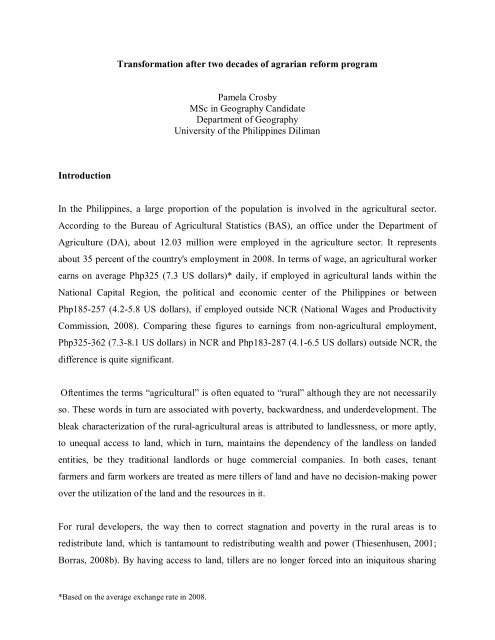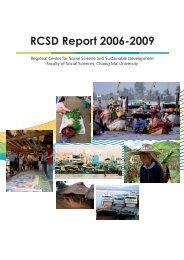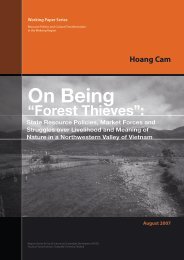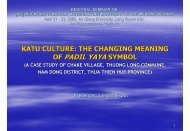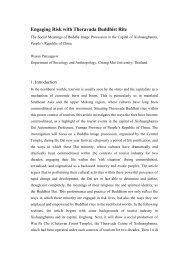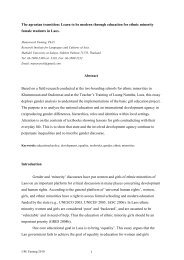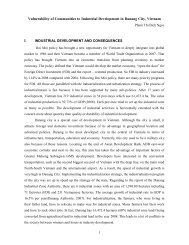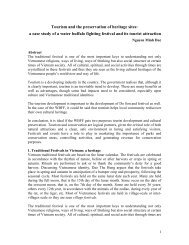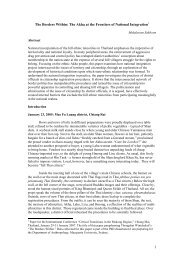Transformation after two decades of agrarian reform ... - RCSD
Transformation after two decades of agrarian reform ... - RCSD
Transformation after two decades of agrarian reform ... - RCSD
Create successful ePaper yourself
Turn your PDF publications into a flip-book with our unique Google optimized e-Paper software.
<strong>Transformation</strong> <strong>after</strong> <strong>two</strong> <strong>decades</strong> <strong>of</strong> <strong>agrarian</strong> <strong>reform</strong> programPamela CrosbyMSc in Geography CandidateDepartment <strong>of</strong> GeographyUniversity <strong>of</strong> the Philippines DilimanIntroductionIn the Philippines, a large proportion <strong>of</strong> the population is involved in the agricultural sector.According to the Bureau <strong>of</strong> Agricultural Statistics (BAS), an <strong>of</strong>fice under the Department <strong>of</strong>Agriculture (DA), about 12.03 million were employed in the agriculture sector. It representsabout 35 percent <strong>of</strong> the country's employment in 2008. In terms <strong>of</strong> wage, an agricultural workerearns on average Php325 (7.3 US dollars)* daily, if employed in agricultural lands within theNational Capital Region, the political and economic center <strong>of</strong> the Philippines or betweenPhp185-257 (4.2-5.8 US dollars), if employed outside NCR (National Wages and ProductivityCommission, 2008). Comparing these figures to earnings from non-agricultural employment,Php325-362 (7.3-8.1 US dollars) in NCR and Php183-287 (4.1-6.5 US dollars) outside NCR, thedifference is quite significant.Oftentimes the terms “agricultural” is <strong>of</strong>ten equated to “rural” although they are not necessarilyso. These words in turn are associated with poverty, backwardness, and underdevelopment. Thebleak characterization <strong>of</strong> the rural-agricultural areas is attributed to landlessness, or more aptly,to unequal access to land, which in turn, maintains the dependency <strong>of</strong> the landless on landedentities, be they traditional landlords or huge commercial companies. In both cases, tenantfarmers and farm workers are treated as mere tillers <strong>of</strong> land and have no decision-making powerover the utilization <strong>of</strong> the land and the resources in it.For rural developers, the way then to correct stagnation and poverty in the rural areas is toredistribute land, which is tantamount to redistributing wealth and power (Thiesenhusen, 2001;Borras, 2008b). By having access to land, tillers are no longer forced into an iniquitous sharing*Based on the average exchange rate in 2008.
system with landlords or pressed into <strong>of</strong>tentimes-onerous wage labor system. Access to land alsomeans freedom to diversify their livelihoods, directly join in the agricultural market, or evenmove away from agriculture.On the other hand, landlords attempt to preserve their landholdings by sidestepping the <strong>agrarian</strong><strong>reform</strong> programs using overt and covert means, from converting agricultural lands into other usesto employing outright armed resistance. Two <strong>decades</strong> <strong>after</strong> the implementation <strong>of</strong> theComprehensive Agrarian Reform Program (CARP) in the Philippines, what has happened then tothe “former” landlords, the beneficiaries <strong>of</strong> the CARP, and their respective lands?This paper outlines some <strong>of</strong> the findings <strong>of</strong> my masteral thesis which examines the impacts <strong>of</strong><strong>agrarian</strong> <strong>reform</strong> on the social relations in the study area and on the production and reproductionspaces in the said community. The study is being conducted on three <strong>agrarian</strong> <strong>reform</strong> (AR) sitesin the municipality <strong>of</strong> Buenavista, namely, Poblacion, Catulin, and Lilukin.Agrarian Reform Impact Studies in the PhilippinesIn the Philippines, most “CARP impact assessment” studies focus on the socioeconomic effects<strong>of</strong> the CARP, particularly on poverty alleviation and policy implications (see studies done byBalisacan, Borras and the PIDS). Many <strong>of</strong> these have been concerned with evaluating the“success” rate <strong>of</strong> the CARP and only a few have been concerned with the spatial effects <strong>of</strong> theprogram on the physical land itself. Among these few is a study done by Ballesteros & de laCruz (2006) who examined the impacts <strong>of</strong> the CARP on land ownership concentration in therice-growing areas in Nueva Ecija, Central Luzon. One <strong>of</strong> the evitable effects <strong>of</strong> the CARP is thedecline <strong>of</strong> large consolidate rice lands and the increase <strong>of</strong> small rice farm landholdings, at leastfor a certain period <strong>of</strong> time. In one <strong>of</strong> the conclusions <strong>of</strong> the author, these <strong>agrarian</strong> <strong>reform</strong> sites inNueva Ecija did not experience much change since farmers who benefited from the CARPeventually re-sold or pawned their lands not necessarily to their old landlords but to new landbuyers, which is also a common practice among the CARP beneficiaries <strong>of</strong> Buenavista, Quezon..What happens is that a new breed <strong>of</strong> landowners is emerging in these villages.2
In relation to this, a study done by Llanto & Dingcong (1991) examine the frequently forgottenactors/stakeholders in the CARP, which are the landowners. Among the important focus <strong>of</strong> thestudy are “the factors that encourage or discourage the shift <strong>of</strong> landowners from agriculture toindustry” and the “impact <strong>of</strong> <strong>agrarian</strong> <strong>reform</strong> on their income and investment behavior”.However, the authors discussed only the economizing behaviors and response <strong>of</strong> landowners tothe CARP and portrayed them as rational “entrepreneurs” which is not always the case,especially in the Philippines where land is laden with political and social functions. It is acommon fact that land <strong>reform</strong> programs are <strong>of</strong>ten met with resistance from large land owningentities.Area <strong>of</strong> StudyBuenavista was established as the 37 th municipality <strong>of</strong> the Province <strong>of</strong> Quezon in thenortheastern Philippines on August 26, 1950. However, it already existed as a small village (or asitio) in the 1800s, founded by Spaniards who settled in the area. It has 37 barangays (thesmallest administrative unit in the Philippines), with a total area <strong>of</strong> 16,135.07 hectares and a totalpopulation <strong>of</strong> 23,834 (as <strong>of</strong> 2003), such that 1.48 people live in an hectare <strong>of</strong> land.Buenavista is a fifth-class municipality, meaning, it has an annual income <strong>of</strong> 10 million pesos to20 million pesos (217,037.4 US dollars to 434,074.9 US dollars), which is practically at thebottom <strong>of</strong> the income classification <strong>of</strong> municipalities in the country. It is part <strong>of</strong> the BondocPeninsula, a sub-region located in the southern portion <strong>of</strong> the province. Buenavista isapproximately 226 km southeast <strong>of</strong> Manila and about 114 km southeast <strong>of</strong> Lucena, QuezonProvince’s capital and lone city.Buenavista is an agricultural municipality, with 62% <strong>of</strong> its total land area (or 10,009 hectares),devoted for agricultural use. Of these 10,009 hectares, 8,153.8 or 81% <strong>of</strong> the agricultural area isplanted with coconut. However, just like the rest <strong>of</strong> the Bondoc Peninsula subregion, has beenhandicapped by its physical geography. This area is characterized by a hilly and mountainoustopography, high soil erodibility, and by leached upland soils. Moreover, this municipality is<strong>of</strong>ten in the path <strong>of</strong> typhoons that originate in the Pacific area.3
Land, Agriculture and the Rise <strong>of</strong> Agrarian ElitesIn the Rise and Fall <strong>of</strong> Elites, the English translation <strong>of</strong> Pareto’s Un applicazione di teoriesociologiche, elite was defined as “the strongest, the most energetic, and the most capable – forgood as well as evil”, and that, “peoples are always governed by an elite.” Mosca, on the otherhand, defined the elite by distinguishing <strong>two</strong> classes <strong>of</strong> people in a society: one that rules and onethat is ruled. He continued,“The first class, always the less numerous, performs all politicalfunctions, monopolizes power and enjoys the advantages thatpower brings, whereas the second, the more numerous class, isdirected and controlled by the first, in a manner that is now moreor less legal, now more or less arbitrary and violent.”While Pareto’s and Mosca’s definitions did not particularly discuss the rise <strong>of</strong> <strong>agrarian</strong> elites,their definitions provide a good starting point in discussing the assent <strong>of</strong> <strong>agrarian</strong> elites and theirroles in rural politics in the Philippines. Questions like how do the elites come to power, andmaintain their ‘legitimacy’ in the countrysides need to be addresses.Wolters (1984), in his Politics, Patronage and Class Conflict in Central Luzon, stated that thelocal elites rose to power when they started to amass lands in rural areas where most <strong>of</strong> supplies<strong>of</strong> land were. This process was a result <strong>of</strong> <strong>two</strong> developments that happened in the country duringthe colonial times: first, the “incorporation <strong>of</strong> prominent native members <strong>of</strong> the population intothe colonial government” and, second, “the opening <strong>of</strong> the Philippine archipelago to the worldmarket” through commodity production. The Spanish colonial government forcibly opened to theinternational market by mandating exportation <strong>of</strong> agricultural products. To produce more cashcrops, many <strong>of</strong> the land owners had their hacienda tilled by peasants under the kasamásharecropping system (or the landlord-tenant system). This started the feudalistic feature <strong>of</strong> therural-agricultural Philippines.The feudalistic relationship between the landlord and the tenants, however, did not remaineconomic. As the landlords flourished economically, they did also politically. Due to their4
financial power, they became the financiers <strong>of</strong> political parties and even became the candidatesthemselves that they eventually became part <strong>of</strong> the Philippine political system (von Albertini,1971; McCoy, 1998). What the country then had at this time were economic and politicallandlords (McCoy, 1998; Hutchcr<strong>of</strong>t, 2000).“Landlordism” and Agrarian Reform in the PhilippinesThe notion and reality <strong>of</strong> power that is equated to ownership <strong>of</strong> land is deeply entrenched in thePhilippine society, even before Christianity and Islam arrived in the country. However, the widescaleacquisition and (mis)appropriation <strong>of</strong> land proliferated during the Spanish period in thecountry, particularly in the lowlands (Wolters, 1984; McCoy, 1993; Veneracion, 2001). Villagesor pueblo, and later on, municipalities were set up while land grants were handed out to obedientimplementers <strong>of</strong> the colonization project <strong>of</strong> the Spanish crown through the encomienda, alcadiaand estancia systems. These systems, wherein large tracts <strong>of</strong> lands were cultivated for cash cropsor used for ranching (Veneracion, 2001:85-103), are feudalistic in nature. Because <strong>of</strong> the prestigeassociated with “owning” large areas <strong>of</strong> land, many individuals started acquiring them on theirown. It was during this period that land grabbing became rampant despite the regalian doctrine.The Spanish Period, and the American Period, subsequently, in the Philippines gave birth to thepresent landlords in the country.‘Landlordism’ or the landlord-tenant system was abolished since the passing <strong>of</strong> the institution <strong>of</strong>the Republic Act 6657 or the Comprehensive Agrarian Reform Law <strong>of</strong> 1988 (CARL <strong>of</strong> 1988),which is the legal basis for the Comprehensive Agrarian Reform Program (CARP). TheComprehensive Agrarian Reform Program (CARP) is a ten-year program that is implemented bythe Department <strong>of</strong> Agrarian Reform (DAR). The deadline for CARP was 1998 but it wasextended until 2008, a decade late <strong>of</strong> the original deadline. However, a recent resolution <strong>of</strong> thePresidential Agrarian Reform Committee (PARC), signed this February 2007, states a plan toextend the program beyond 2008.‘Agrarian <strong>reform</strong>’ is defined as:“the redistribution <strong>of</strong> lands, regardless <strong>of</strong> crops or fruits produced,to farmers and regular farm workers who are landless, irrespective5
<strong>of</strong> tenurial arrangement, to include the totality <strong>of</strong> factors andsupport services designed to lift the economic status <strong>of</strong> thebeneficiaries and all other arrangements alternative to the physicalredistribution <strong>of</strong> lands, such as production or pr<strong>of</strong>it-sharing, laboradministration, and the distribution <strong>of</strong> shares <strong>of</strong> stock, which willallow beneficiaries to receive a just share <strong>of</strong> the fruits <strong>of</strong> the landsthey work.” (RA 6657, Section 3a)This was reiterated by DAR, the main body tasked to implement the CARP:“Agrarian <strong>reform</strong> is the redistribution <strong>of</strong> agricultural lands t<strong>of</strong>armers and regular farmworkers who are landless, irrespective <strong>of</strong>tenurial arrangement. It includes the provision <strong>of</strong> support servicessuch as: credit extension, irrigation, roads and bridges, marketingfacilities, human resource and institutional development.”Agrarian <strong>reform</strong>, therefore, does not only mean redistribution <strong>of</strong> lands but providing thebeneficiaries with extension services and incentives to the beneficiaries.However, despite the delay in meeting the deadline for the CARP, the government is positivethat it is producing concrete results as evidenced in DAR’s 2006 Annual AccomplishmentReport. DAR reported that it was able to distribute 96% <strong>of</strong> its targeted 130,000 hectares for thatparticular year. The government’s optimism was bolstered by positive praises from internationalobservers, as reflected in a news article published in DAR’s website citing the country as amodel for <strong>agrarian</strong> <strong>reform</strong> implementation (“Int’l. rural dev’t planners: laud RP <strong>agrarian</strong>program”, May 31, 2007, http://www.dar.gov.ph). Ironically, at the same page, another headlinereads, “Police, soldiers key to CARP’s success” (May 31, 2007, http://www.dar.gov.ph). Thismentions the violence associated with the implementation <strong>of</strong> the CARP in areas that arecontrolled by prominent figures, usually politicians and businessmen. This same conflict echoesthe same resistance from many <strong>of</strong> the lawmakers, staged at the time when CARL was still a bill.Many congressmen objected to the provisions <strong>of</strong> the bill because it threatens their own large6
landholdings back in their provinces. These legislators were not only political elites, but were,firstly, <strong>agrarian</strong> elites.Fragmentation <strong>of</strong> Land, Redistribution <strong>of</strong> Power?In the Philippine countryside, land remains in the core <strong>of</strong> resource conflicts, and parallel to these,<strong>of</strong> the rural development agenda. The dichotomy between the landed and the landless continuesto define the political, economic, and socio-cultural landscapes <strong>of</strong> the rural areas. In a countrywhere most people still depend on agriculture, land remains one <strong>of</strong> the most important “factor <strong>of</strong>production” or capital. However, it is also true that land is more than an economic factor. It haspolitical and social functions such that in many rural areas in the Philippines, control <strong>of</strong> the landmeans control <strong>of</strong> the people within this land. Land-owning entities occupy the upper tier <strong>of</strong>society – they are the wealthy, the force that can dictate the development trajectory (or lackthere<strong>of</strong>) <strong>of</strong> barangays, towns, even provinces, they are the ones whereupon the landless aredepending on for socioeconomic and political security. Land means power.The series <strong>of</strong> <strong>agrarian</strong> <strong>reform</strong> programs in the Philippines aimed to rectify the problem <strong>of</strong>inequality based on land ownership through the redistribution scheme. The ComprehensiveAgrarian Law <strong>of</strong> 1988 mandated the abolishment <strong>of</strong> the tenancy system in the country to makeway for a society where first, no one is excluded from access to land and other capitals, and <strong>two</strong>,access to these resources is equal for everyone.More than the fragmentation <strong>of</strong> lands, land redistribution projects have more pr<strong>of</strong>ound effects.Going back to the premise <strong>of</strong> the CARP, it aims to upset the existing power relations between thetenants, farm workers and other beneficiaries and the landlords by providing a “level” playingfield. For the past <strong>decades</strong>, a number <strong>of</strong> studies conducted particularly by the Popular Institutefor Democratic Studies (PIDS) (see Llanto & Dingcong, 1991; Sanchez, 1991; Geron, 1994;Reyes, 2002; Llantos & Ballesteros, 2003; Ballesteros & de la Cruz, 2006; Adriano, 2008;Ballesteros & Cortes, 2008; Leonen, 2008) assessed the socioeconomic impacts and policyimplications <strong>of</strong> the CARP. Most <strong>of</strong> these studies reflect the failure <strong>of</strong> the program in achievingits goals, thereby, presenting only pictures <strong>of</strong> a “stagnant” rural, i.e., low-density in terms <strong>of</strong>settlements; agricultural, i.e., land use is still predominated by crops production, countryside,7
which are not particularly accurate; and one that is still defined by traditional patron-clientbonds.Buenavista presents a classic example <strong>of</strong> what seems to be “feudalistic” society, or one that ischaracterized by landlord-tenant/patron-client relationship. Ownership <strong>of</strong> most <strong>of</strong> the lands isconcentrated to only a few families, among them the Reyes and the Uy families (Franco, 2005).During the Marcos regime, the Reyeses in particular, rose to political power and held theleadership <strong>of</strong> the local government unit <strong>of</strong> Buenavista from 1972 until 1986. It was during thistime that they supposedly amassed most <strong>of</strong> the lands in the municipality. After the collapse <strong>of</strong> theMarcos government, they were able to re-establish their power as economic and political elites inthe area by employing the classic “guns, goons, and gold” operandi. To counter these forces, theNew People’s Army (NPA) has also entered the area. Since then, this municipality, just like theBondoc Peninsula in general, has become a hotspot for violent encounters between the armedlandlords, the NPA, and the military. Because <strong>of</strong> the “reign <strong>of</strong> terror” in this municipality,Buenavista is practically cut <strong>of</strong>f from other outside influences.By exercising various forms <strong>of</strong> power play, those in power aim that certain persons, perspectives,issues or conflicts never enter the overt political arena, thereby, maintaining the status quo. Theimplementation <strong>of</strong> the CARP has led many landlords to practice all their means <strong>of</strong> power to resistthe program. Either they overtly refuse to participate in the program or they circumvent the law.Yet, despite this resistance, Buenavista has a strong farmers cooperative and a functioningMunicipal Agrarian Reform Office (MARO). These <strong>two</strong> were instrumental in winning the casebetween a group <strong>of</strong> farmers in one <strong>of</strong> the <strong>agrarian</strong> <strong>reform</strong> sites and the Domingo Reyes estate,owned by the one <strong>of</strong> the most influential and powerful families in Bondoc Peninsula. InDecember 1998, the farmers were granted almost 164 hectares <strong>of</strong> the hacienda (Franco, 2005).As <strong>of</strong> 2006, other pockets <strong>of</strong> <strong>agrarian</strong> <strong>reform</strong> areas have dotted the once consolidatedlandholdings <strong>of</strong> the said family.It is important to note the complexities <strong>of</strong> Buenavista. The “success” <strong>of</strong> the land redistributionprogram in this municipality is said to be attributed to several factors: 1) the presence <strong>of</strong>organized farmers group, in the form <strong>of</strong> a cooperative, that openly fought for its members’8
claims to the land; 2) a functioning Municipal Agrarian Reform Office (MARO), which is themain implementer <strong>of</strong> the CARP in the local communities, 3) the entry <strong>of</strong> local and foreignnongovernmental organizations (NGOs), civil society and other <strong>agrarian</strong>/rural <strong>reform</strong> advocategroups that assist the farmers/tenants in their fight for their lands, and 4) the overt and covertinitiatives practiced by the farmers at the individual level to oppose the existing large landowners in the area. On the other hand, there are also factors that stall the success <strong>of</strong> the <strong>agrarian</strong><strong>reform</strong> program in Buenavista: 1) the continuing influx <strong>of</strong> migrants, mostly landless farmers,from the Bicol region, who eventually become dependent on land owning entities; 2) the new“propaganda” and tactics used by these landlords to halt the CARP program like conversion <strong>of</strong>their remaining landholdings into non-agricultural lands and re-buying back lands from theCARP beneficiaries; and 3) CARP grantees who re-sell or pawn their lands to their formerlandlords.Agrarian Reform and the PeasantsThe remaining hacienda <strong>of</strong> the Reyeses in Buenavista has about 155 tenants, subject to the 70-30crop sharing system (locally known as tersyohan), in favor <strong>of</strong> the landlord. Among these tenantsare caretakers or overseers cum ‘estate managers’, locally known as enkargados, <strong>of</strong> the coconutplantations. They are the most trusted men <strong>of</strong> the landowner. The landowners do not directlynegotiate with their tenants but through these enkargados. This implies a hierarchy within thetenants: the caretakers/overseers/managers/enkargados above the ordinary tenants who workdirectly on the land.Prior to the <strong>agrarian</strong> <strong>reform</strong>, harvests <strong>of</strong> the tenants are turned over to the enkargados who, inturn, would oversee the processing <strong>of</strong> the nuts into copra. Ordinarily, the same tenants whoharvested the nuts would transport the nuts to the drying area, de-husk and cook (throughsmoking) the nuts to become copra. The enkargado would then sell the copra to coconut buyers,usually, in the capital town <strong>of</strong> Quezon, Province. The pr<strong>of</strong>it from this would be divided betweenthe landlord who gets 70% <strong>of</strong> the share and the enkargado who gets the remaining share. Theenkargado, in turn, ‘pays’ the tenants at a rate <strong>of</strong> P10 per kilo <strong>of</strong> copra that were produced, withadditional payments for their extra labor. However, during the land redistribution program, thisReyeses started to engage the services <strong>of</strong> non-tenants who are willing to work as farm workers in9
the hacienda. This has been a source <strong>of</strong> conflict between the ‘legitimate’ tenants and theoutsiders.According to some <strong>of</strong> the tenants <strong>of</strong> the hacienda, during and <strong>after</strong> the process <strong>of</strong> theredistribution <strong>of</strong> the Reyes’ lands to the beneficiaries, the landowners, through the enkargados,started hiring farmworkers from other barangays and municipalities into the plantation. It was aploy to show the local <strong>agrarian</strong> <strong>reform</strong> <strong>of</strong>fice that the Reyeses have no remaining tenants.However, this scheme displaced more than ten families who are legitimate tenants <strong>of</strong> theplantation. The displaced households are now ‘squatters’ on the land they once tilled.Moreover, the landlords have been blaming the <strong>agrarian</strong> <strong>reform</strong> for the shutting down <strong>of</strong> the <strong>two</strong>oil mills, reasoning that because their coconut plantations were reduced to more than half <strong>of</strong> theiroriginal sizes, the supply coconut coming from the remaining area <strong>of</strong> the plantation can notsupport the operation <strong>of</strong> the oil mills.Emerging Actors in the Agricultural IndustryWhile the Reyeses remain to dominate and control the municipality and its political andeconomic structures, a number <strong>of</strong> actors and groups are starting to emerge as players in thecoconut industry <strong>of</strong> this locality. They may be in the form <strong>of</strong> independent coconut traders,individuals who took the land redistribution program as an opportunity to provide alternatives tothe new small holders <strong>of</strong> lands by setting up relatively higher buying price for copra (12-14 pesosversus the fixed ten pesos rate at the hacienda).Corporations have also started to tap the human labor <strong>of</strong> the municipality by contracting them tobe farmworkers in their own plantations. One <strong>of</strong> these attempts was the plan <strong>of</strong> San MiguelCorporation to initiate a cassava planting program in Buenavista. Produce from these farmswould be used to supply the beer manufacturing <strong>of</strong> this corporation. However, this plan did notpush through, much to the disappointment <strong>of</strong> the local people.One <strong>of</strong> the significant events in Buenavista is the emergence <strong>of</strong> peasant organizations andfarmers cooperatives which, <strong>after</strong> winning their battles against the Reyeses for their rights to10
their own lands, became an empowering tool for its members. These cooperatives and groupsprovide its members capital through credit system to start up their own farms.Despite the changes brought about by the <strong>agrarian</strong> <strong>reform</strong> program and the emergingopportunities for the population <strong>of</strong> Buenavista, this place and its people remain tied to theReyeses. Why this is so?This may be explained by the persisting patron-client culture in Buenavista. While some tenantswere able to acquire their own lands, they were not fully emancipated from their bondage to theirformer landlords. For one, they cannot freely exercise their new-found ‘freedom’ because themunicipality is militarized. This can be observed by the presence <strong>of</strong> military checkpoints andmilitary personnel regularly patrolling the municipality. These are supposedly means to interceptmembers <strong>of</strong> the NPA. Some farmers, however, claim that these are surveillance ploys <strong>of</strong> theReyeses to identify individuals or groups, like the farmers associations, who are plotting againstthe clan. This paranoia is so obvious that new comers in the municipality like migrants have toendure frequent ‘visitations’ from the military or the police. Even researchers are treatedcircumspectly, and kept close, by the mayor’s minions, under the guise <strong>of</strong> protecting the peoplefrom possible NPA harassment while in the area. The Reyeses also try to proliferate this anti-NPA attitude by casting the latter into bad light and accusing them <strong>of</strong> extortion (in the form <strong>of</strong>revolutionary tax collection, which, according to the government, the proceeds do not go to thepeople but to the NPA members’ pockets), theft and harassment. The military is necessary toprotect the people from these aggravations. The whole municipality then becomes under the‘protection’ <strong>of</strong> the government, which, in this case, is the Reyeses.Migrants and the Persistence <strong>of</strong> Patron-Client RelationshipBecause <strong>of</strong> its proximity to the Bicol and Visayas regions, Buenavista has been experiencing asteady inflow <strong>of</strong> migrants. Ironically, these migrants are landless families escaping poverty intheir own hometowns. All <strong>of</strong> those who ended up in Buenavista became squatters in the Reyeses’lands. These people have been permitted by Mayor Reyes to put up their houses in his lands butforbidden them to till the land. This leads to total dependency on the part <strong>of</strong> the migrants to the11
Reyeses. Some <strong>of</strong> them seek and are able to work as farmworkers in the hacienda, either asharvesters, nut collectors, or de-huskers. However, these ‘jobs’ do not pay much and tootemporary. There are no other employments available in the municipality. Clerical positions inthe municipal hall were already occupied by people who have connections with the mayor.Engaging in the transportation sector is not an option either since the migrants do not have thecapital to buy or rent vehicles, in the first place. The only option left is farming or fishing, thelatter still underdeveloped, and so, unpr<strong>of</strong>itable. Since the migrants do not have access to lands,some <strong>of</strong> them resort to stealing coconuts (or paglulusot) or other crops from the plantation.Others have no choice but to use a portion <strong>of</strong> their ‘backyard’ to plant vegetables or corn, even ifthis is prohibited. Many <strong>of</strong> them are caught by the military who are regularly monitoring themigrants/squatters in the Reyeses’ lands.Persisting PatronageThe Comprehensive Agrarian Reform Law <strong>of</strong> 1988 aims first, “promote social justice justice”,second, “move the nation toward sound rural development and industrialization”,and third,establish “owner cultivatorship <strong>of</strong> economic-sized farms as the basis <strong>of</strong> Philippine agriculture”by prioritizing the “welfare <strong>of</strong> the landless” and a “more equitable distribution and ownership <strong>of</strong>land.” With the CARP, large landholdings <strong>of</strong> family elites like the Reyeses were alreadyfragmented, if not completely presumably, and distributed to once landless tenants. However,bondage to these elites persists. Does it only show that the <strong>agrarian</strong> <strong>reform</strong> has freed thesetenants in title only but not politically, economically and socially? This is so the case, at least inBuenavista, where the <strong>agrarian</strong> <strong>reform</strong> program did not necessarily emancipated the peasantsfrom the onerous patronage system. For many years to come, this will be the case if thegovernment itself is dominated by <strong>agrarian</strong> elites who control the economic and political powersthat legitimize their authority over the masses.REFERENCESAdriano, F.D. (2008). CARP institutional assessment in a post-2008 transition scenario: Towarda new rural development architecture. Discussion Paper Series 2008-06. Quezon City:Philippine Institute for Development Studies.12
Bachrach, P. and Baratz, M.S. (1962). “The Two Faces <strong>of</strong> Power.” American Political ScienceReview 56, 941-52.Ballesteros, M. & Cortez, F. (2008). CARP institutional assessment in a post-2008 transitionscenario: Implications for land administration and management, Discussion Paper Series2008-07. Quezon City: Philippine Institute for Development Studies.Ballesteros, M. & de la Cruz, A. (2006). Land <strong>reform</strong> and changes in land ownershipconcentration: Evidence from rice-growing villages in the Philippines. Discussion PaperSeries 2006-21. Quezon City: Philippine Institute for Development Studies.Bello, W., Docena, H.; De Guzman, M.; and Malig, M.L. (2004). Multilateral punishment: thePhilippines in the WTO, 1995-2003 The anti-development state: Tthe political economy<strong>of</strong> permanent crisis in the Philippines. Quezon City: University <strong>of</strong> the Philippines Press.Bernstein, H. (1994). Agrarian classes in capitalist development. In L. Sklair (Ed.), Capitalismand development. New York and London: Routledge.Bernstein, H. & Byres, T. (2001). From peasant studies to <strong>agrarian</strong> change. Journal <strong>of</strong> AgrarianChange, 1 (1), 1-56.Borras, S., Jr. (2008a). Competing Views and Strategies on Agrarian Reform, Volume I:International Perspective. Quezon City: Ateneo de Manila University Press.Borras, S., Jr. (2008b). Competing Views and Strategies on Agrarian Reform, Volume II:Philippine Perspective. Quezon City: Ateneo de Manila University Press.Borras, S., Jr. (1998). The bibingka strategy in land <strong>reform</strong> implementation : autonomouspeasant movements and state <strong>reform</strong>ists in the Philippines. Quezon City : Institute forPopular Democracy13
Connelly, J. & Smith, G. (1999). Politics and the environment: From theory to practice. London& New York: Routledge.Dahl, R. (1957). The Concept <strong>of</strong> Power. Behavioral Science 2, 201-15.Department <strong>of</strong> Agriculture-Agribusiness and Marketing Assistance Service (DA-AMAS).(1999). Coconut industry situationer report, accessed atEder, J. F. (1993). Family farming and household enterprise in a Philippine community, 1971-1988. Journal <strong>of</strong> Asian Studies, 52(3), 647-671.Franco, J. (2005). On just grounds: The new struggle for land and democracy in BondocPeninsula. In J. Franco & S. Borras, Jr. (Eds.), On just grounds : Struggling for <strong>agrarian</strong>justice and citizenship rights in the rural Philippines. Quezon City: Institute for PopularDemocracy.Franco, J. & Borras, S., Jr. (Eds.) (2005). On just grounds: Struggling for <strong>agrarian</strong> justice andcitizenship rights in the rural Philippines. Quezon City: Institute for Popular Democracy.Geron, M.P. (1994). The impact <strong>of</strong> Comprehensive Agrarian Reform Program (CARP) on thecrop sector. Discussion Paper Series 1994-14. Quezon City: Philippine Institute forDevelopment Studies.Hart, G., Turton, A. & White, B. (1992). Agrarian transformation, local processes and the statein Southeast Asia. Berkeley and Loas Angeles: University <strong>of</strong> California Press.Houston, Charles O., Jr. (1953). The Philippine coconut industry, 1934-1950 PhilippineGeographical Journal, 1(2&3), 61-90.14
Hutchcr<strong>of</strong>t, P.(2002). Colonial masters, national politicos and provincial lords: central authorityand local autonomy in the American Philippines 1900–1913, Journal <strong>of</strong> Asian Studies,59, 277–306.Kerkvliet, B. (1991). Everyday politics in the Philippines: class and status relations in a CentralLuzon Village. Quezon City: New Day Publishers.Lactao, Ernesto. (1990). Structural adjustments in the coconut industry: an analysis <strong>of</strong> currentpolicies and development alternatives. Saliksik, Research Paper, Philippine PeasantInstitute, Quezon City, Philippines.Leonen, M. (2008). CARP institutional assessment in a post-2008 transition scenario: Reformsfor the <strong>agrarian</strong> justice system. Discussion Paper Series 2008-10. Quezon City: PhilippineInstitute for Development Studies.Llanto, G. & Ballesteros, M. (2003). Land issues in poverty reduction strategies and thedevelopment agenda: Philippines. Discussion Paper Series 2003-03. Quezon City:Philippine Institute for Development Studies.Llanto, G. & Dingcong, C. (1991). Impact <strong>of</strong> <strong>agrarian</strong> <strong>reform</strong> on landowners: A review <strong>of</strong>literature and a framework. Discussion Paper Series 1991-14. Quezon City: PhilippineInstitute for Development Studies.Llorito, D.L. (2002). Quezon's feudal system blamed for insurgency. Accessed atMaunahan, M.V.; Huelgas, Z.M.; Sardido, M.L.; Alino, J.B.; Deomampo, N.R. (1998).Commodity industry analysis: coconut. Commodity Industry Analysis Ser. No. 4.McCoy, A.W. (ed.). (1998). Anarchy <strong>of</strong> families: state and families in the Philippines. QuezonCity, Philippines: Ateneo de Manila University Press.15
Morales, H., Jr.; Putzel, J., Lara, F., Jr. &Quitoriano, E. (Eds.) (2001). Agrarian <strong>reform</strong>, ruralpolitics, institutional change and globalization. Quezon City: Project DevelopmentInstitute.Park, Seung Woo and Green, Gary P. (1995). Agricultural restructuring and capitalistindustrialization: the cases <strong>of</strong> South Korea and the Philippines, Kasarinlan, 11 (2), 103-148.Putzel, James. (2002). A captive land : the politics <strong>of</strong> <strong>agrarian</strong> <strong>reform</strong> in the Philippines.London: Monthly Review Press, 1992.Reyes, C. (2002). Impact <strong>of</strong> <strong>agrarian</strong> <strong>reform</strong> on poverty. Discussion Paper Series 2002-02.Quezon City: Philippine Institute for Development Studies.Rigg, J. (2001). More than the soil: Rural change in Southeast Asia. Harlow: Prentice Hall.Rigg, J. (1997). Southeast Asia: The human landscape <strong>of</strong> modernization and development.London: Routledge.Roseberry, W. (1983). From peasant studies to proletarianization studies. Studies in ComparativeInternational Development, 18(1/2), 69-89.Scott, J. (1976). The moral economy <strong>of</strong> the peasant : rebellion and subsistence in Southeast Asia.New Haven: Yale University Press.Scott, J. (1985). Weapons <strong>of</strong> the weak: everyday forms <strong>of</strong> peasant resistance. New Haven andLondon: Yale University Press.Scott, J. & Kerkvliet, B. (eds.) (1986). Everyday forms <strong>of</strong> peasant resistance in Southeast Asia,Journal <strong>of</strong> Peasant Studies, 13 (2).16
Scott, J. & Kerkvliet, B. (1973). The politics <strong>of</strong> survival: peasant response to ‘progress’ inSoutheast Asia”, Journal <strong>of</strong> Southeast Asian Studies, 4 (2), 241-268.Shanin, T. (1989). Peasants and peasant Societies, 2 nd Edition. Oxford: Basil and Blackwell.Thiesenhusen, W. (2001). Poverty amidst plenty. In H. Morales et al (Eds.). Agrarian <strong>reform</strong>,rural politics, institutional change and globalization. Quezon City: Project DevelopmentInstitute.Thorner, D., Kerblay, B. & Smith, R.E.F. (eds.). (1966). A.V. Chayanov on the Theory <strong>of</strong>Peasant Economy. Madison: University <strong>of</strong> Wisconsin Press.Tiglao, R. (1980). The political economy <strong>of</strong> the Philippine coconut industry. Third WorldStudies. Commodity Studies No. 1, December 1980.United Coconut Association <strong>of</strong> the Philippines, Inc. (UCAP). (1980). The socio-economic pr<strong>of</strong>ile<strong>of</strong> the coconut farmers in the Quezon-Batangas-Laguna (QBL) area. Manila: UCAP.Zoleta-Nantes, D. B. Z. (2001). A process-documentation <strong>of</strong> the community managed <strong>agrarian</strong><strong>reform</strong> program. An unpublished report submitted to the Department <strong>of</strong> AgrarianReform, Quezon City, Philippines.17


